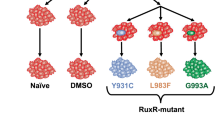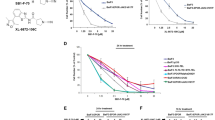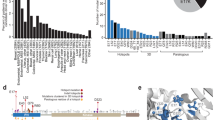Abstract
The transforming JAK2V617F kinase is frequently associated with myeloproliferative neoplasms and thought to be instrumental for the overproduction of myeloid lineage cells. Several small molecule drugs targeting JAK2 are currently in clinical development for treatment in these diseases. We performed a high-throughput in vitro screen to identify point mutations in JAK2V617F that would be predicted to have potential clinical relevance and associated with drug resistance to the JAK2 inhibitor ruxolitinib (INCB018424). Seven libraries of mutagenized JAK2V617F cDNA were screened to specifically identify mutations in the predicted drug-binding region that would confer resistance to ruxolitinib, using a BaF3 cell-based assay. We identified five different non-synonymous point mutations that conferred drug resistance. Cells containing mutations had a 9- to 33-fold higher EC50 for ruxolitinib compared with native JAK2V617F. Our results further indicated that these mutations also conferred cross-resistance to all JAK2 kinase inhibitors tested, including AZD1480, TG101348, lestaurtinib (CEP-701) and CYT-387. Surprisingly, introduction of the ‘gatekeeper’ mutation (M929I) in JAK2V617F affected only ruxolitinib sensitivity (fourfold increase in EC50). These results suggest that JAK2 inhibitors currently in clinical trials may be prone to resistance as a result of point mutations and caution should be exercised when administering these drugs.
This is a preview of subscription content, access via your institution
Access options
Subscribe to this journal
Receive 12 print issues and online access
$259.00 per year
only $21.58 per issue
Buy this article
- Purchase on Springer Link
- Instant access to full article PDF
Prices may be subject to local taxes which are calculated during checkout



Similar content being viewed by others
References
Levine RL, Gilliland DG . Myeloproliferative disorders. Blood 2008; 112: 2190–2198.
James C, Ugo V, Le Couedic JP, Staerk J, Delhommeau F, Lacout C et al. A unique clonal JAK2 mutation leading to constitutive signalling causes polycythaemia vera. Nature 2005; 434: 1144–1148.
Lucet IS, Fantino E, Styles M, Bamert R, Patel O, Broughton SE et al. The structural basis of Janus kinase 2 inhibition by a potent and specific pan-Janus kinase inhibitor. Blood 2006; 107: 176–183.
Williams NK, Bamert RS, Patel O, Wang C, Walden PM, Wilks AF et al. Dissecting specificity in the Janus kinases: the structures of JAK-specific inhibitors complexed to the JAK1 and JAK2 protein tyrosine kinase domains. J Mol Biol 2009; 387: 219–232.
Lu X, Levine R, Tong W, Wernig G, Pikman Y, Zarnegar S et al. Expression of a homodimeric type I cytokine receptor is required for JAK2V617F-mediated transformation. Proc Natl Acad Sci USA 2005; 102: 18962–18967.
Wernig G, Gonneville JR, Crowley BJ, Rodrigues MS, Reddy MM, Hudon HE et al. The Jak2V617F oncogene associated with myeloproliferative diseases requires a functional FERM domain for transformation and for expression of the Myc and Pim proto-oncogenes. Blood 2008; 111: 3751–3759.
Verstovsek S, Kantarjian H, Mesa RA, Pardanani AD, Cortes-Franco J, Thomas DA et al. Safety and efficacy of INCB018424, a JAK1 and JAK2 inhibitor, in myelofibrosis. N Engl J Med 2010; 363: 1117–1127.
Pardanani A, Gotlib JR, Jamieson C, Cortes JE, Talpaz M, Stone RM et al. Safety and efficacy of TG101348, a selective JAK2 inhibitor, in myelofibrosis. J Clin Oncol 2011; 29: 789–796.
Tefferi A, Pardanani A . JAK inhibitors in myeloproliferative neoplasms: rationale, current data and perspective. Blood Rev 2011; 25: 229–237.
Hedvat M, Huszar D, Herrmann A, Gozgit JM, Schroeder A, Sheehy A et al. The JAK2 inhibitor AZD1480 potently blocks Stat3 signaling and oncogenesis in solid tumors. Cancer Cell 2009; 16: 487–497.
Pardanani A, Lasho T, Smith G, Burns CJ, Fantino E, Tefferi A . CYT387, a selective JAK1/JAK2 inhibitor: in vitro assessment of kinase selectivity and preclinical studies using cell lines and primary cells from polycythemia vera patients. Leukemia 2009; 23: 1441–1445.
Quintas-Cardama A, Vaddi K, Liu P, Manshouri T, Li J, Scherle PA et al. Preclinical characterization of the selective JAK1/2 inhibitor INCB018424: therapeutic implications for the treatment of myeloproliferative neoplasms. Blood 2010; 115: 3109–3117.
Tyner JW, Bumm TG, Deininger J, Wood L, Aichberger KJ, Loriaux MM et al. CYT387, a novel JAK2 inhibitor, induces hematologic responses and normalizes inflammatory cytokines in murine myeloproliferative neoplasms. Blood 2010; 115: 5232–5240.
Wernig G, Kharas MG, Okabe R, Moore SA, Leeman DS, Cullen DE et al. Efficacy of TG101348, a selective JAK2 inhibitor, in treatment of a murine model of JAK2V617F-induced polycythemia vera. Cancer Cell 2008; 13: 311–320.
George DJ, Dionne CA, Jani J, Angeles T, Murakata C, Lamb J et al. Sustained in vivo regression of Dunning H rat prostate cancers treated with combinations of androgen ablation and Trk tyrosine kinase inhibitors, CEP-751 (KT-6587) or CEP-701 (KT-5555). Cancer Res 1999; 59: 2395–2401.
Hexner EO, Serdikoff C, Jan M, Swider CR, Robinson C, Yang S et al. Lestaurtinib (CEP701) is a JAK2 inhibitor that suppresses JAK2/STAT5 signaling and the proliferation of primary erythroid cells from patients with myeloproliferative disorders. Blood 2008; 111: 5663–5671.
Levis M, Allebach J, Tse KF, Zheng R, Baldwin BR, Smith BD et al. A FLT3-targeted tyrosine kinase inhibitor is cytotoxic to leukemia cells in vitro and in vivo. Blood 2002; 99: 3885–3891.
Strock CJ, Park JI, Rosen M, Dionne C, Ruggeri B, Jones-Bolin S et al. CEP-701 and CEP-751 inhibit constitutively activated RET tyrosine kinase activity and block medullary thyroid carcinoma cell growth. Cancer Res 2003; 63: 5559–5563.
Cools J, Stover EH, Boulton CL, Gotlib J, Legare RD, Amaral SM et al. PKC412 overcomes resistance to imatinib in a murine model of FIP1L1-PDGFRalpha-induced myeloproliferative disease. Cancer Cell 2003; 3: 459–469.
Gorre ME, Mohammed M, Ellwood K, Hsu N, Paquette R, Rao PN et al. Clinical resistance to STI-571 cancer therapy caused by BCR-ABL gene mutation or amplification. Science 2001; 293: 876–880.
Pao W, Miller VA, Politi KA, Riely GJ, Somwar R, Zakowski MF et al. Acquired resistance of lung adenocarcinomas to gefitinib or erlotinib is associated with a second mutation in the EGFR kinase domain. PLoS Med 2005; 2: e73.
Schindler T, Bornmann W, Pellicena P, Miller WT, Clarkson B, Kuriyan J . Structural mechanism for STI-571 inhibition of abelson tyrosine kinase. Science 2000; 289: 1938–1942.
Tamborini E, Bonadiman L, Greco A, Albertini V, Negri T, Gronchi A et al. A new mutation in the KIT ATP pocket causes acquired resistance to imatinib in a gastrointestinal stromal tumor patient. Gastroenterology 2004; 127: 294–299.
Bikadi Z, Hazai E . Application of the PM6 semi-empirical method to modeling proteins enhances docking accuracy of AutoDock. J Cheminform 2009; 1: 15.
Morris GM, Goodsell DS, Halliday RS, Huey R, Hart WE, Belew RK et al. Automated docking using a Lamarckian genetic algorithm and an empirical binding free energy function. J Comput Chem 1998; 19: 1639–1662.
Walz C, Crowley BJ, Hudon HE, Gramlich JL, Neuberg DS, Podar K et al. Activated Jak2 with the V617F point mutation promotes G1/S phase transition. J Biol Chem 2006; 281: 18177–18183.
Azam M, Latek RR, Daley GQ . Mechanisms of autoinhibition and STI-571/imatinib resistance revealed by mutagenesis of BCR-ABL. Cell 2003; 112: 831–843.
Ray A, Cowan-Jacob SW, Manley PW, Mestan J, Griffin JD . Identification of BCR-ABL point mutations conferring resistance to the Abl kinase inhibitor AMN107 (nilotinib) by a random mutagenesis study. Blood 2007; 109: 5011–5015.
Bercovich D, Ganmore I, Scott LM, Wainreb G, Birger Y, Elimelech A et al. Mutations of JAK2 in acute lymphoblastic leukaemias associated with Down's syndrome. Lancet 2008; 372: 1484–1492.
Mullighan CG, Zhang J, Harvey RC, Collins-Underwood JR, Schulman BA, Phillips LA et al. JAK mutations in high-risk childhood acute lymphoblastic leukemia. Proc Natl Acad Sci USA 2009; 106: 9414–9418.
Reiter A, Walz C, Watmore A, Schoch C, Blau I, Schlegelberger B et al. The t(8;9)(p22;p24) is a recurrent abnormality in chronic and acute leukemia that fuses PCM1 to JAK2. Cancer Res 2005; 65: 2662–2667.
Yoda A, Yoda Y, Chiaretti S, Bar-Natan M, Mani K, Rodig SJ et al. Functional screening identifies CRLF2 in precursor B-cell acute lymphoblastic leukemia. Proc Natl Acad Sci USA 2010; 107: 252–257.
Azam M, Seeliger MA, Gray NS, Kuriyan J, Daley GQ . Activation of tyrosine kinases by mutation of the gatekeeper threonine. Nat Struct Mol Biol 2008; 15: 1109–1118.
Zhao L, Dong H, Zhang CC, Kinch L, Osawa M, Iacovino M et al. A JAK2 interdomain linker relays Epo receptor engagement signals to kinase activation. J Biol Chem 2009; 284: 26988–26998.
Hornakova T, Springuel L, Devreux J, Dusa A, Constantinescu SN, Knoops L et al. Oncogenic JAK1 and JAK2-activating mutations resistant to ATP-competitive inhibitors. Haematologica 2011; 96: 845–853.
Koptyra M, Cramer K, Slupianek A, Richardson C, Skorski T . BCR/ABL promotes accumulation of chromosomal aberrations induced by oxidative and genotoxic stress. Leukemia 2008; 22: 1969–1972.
Sattler M, Verma S, Shrikhande G, Byrne CH, Pride YB, Winkler T et al. The BCR/ABL tyrosine kinase induces production of reactive oxygen species in hematopoietic cells. J Biol Chem 2000; 275: 24273–24278.
Reddy MM, Fernandes MS, Salgia R, Levine RL, Griffin JD, Sattler M . NADPH oxidases regulate cell growth and migration in myeloid cells transformed by oncogenic tyrosine kinases. Leukemia 2011; 25: 281–289.
Marubayashi S, Koppikar P, Taldone T, Abdel-Wahab O, West N, Bhagwat N et al. HSP90 is a therapeutic target in JAK2-dependent myeloproliferative neoplasms in mice and humans. J Clin Invest 2010; 120: 3578–3593.
Swords R, Kelly K, Carew J, Nawrocki S, Mahalingam D, Sarantopoulos J et al. The Pim kinases: new targets for drug development. Curr Drug Targets 2011; e-pub ahead of print 21 July 2011; doi: 10.2174/1389211217771934501.
Acknowledgements
This work was supported in part by National Institutes of Health Grant CA134660-04 (to MS).
Author information
Authors and Affiliations
Corresponding author
Ethics declarations
Competing interests
The authors declare no conflict of interest.
Rights and permissions
About this article
Cite this article
Deshpande, A., Reddy, M., Schade, G. et al. Kinase domain mutations confer resistance to novel inhibitors targeting JAK2V617F in myeloproliferative neoplasms. Leukemia 26, 708–715 (2012). https://doi.org/10.1038/leu.2011.255
Received:
Accepted:
Published:
Issue Date:
DOI: https://doi.org/10.1038/leu.2011.255
Keywords
This article is cited by
-
JAK2 inhibitors for the treatment of Philadelphia-negative myeloproliferative neoplasms: current status and future directions
Molecular Diversity (2023)
-
JAK2 inhibitor persistence in MPN: uncovering a central role of ERK activation
Blood Cancer Journal (2022)
-
Role of JAK inhibitors in myeloproliferative neoplasms: current point of view and perspectives
International Journal of Hematology (2022)
-
Transient prenatal ruxolitinib treatment suppresses astrogenesis during development and improves learning and memory in adult mice
Scientific Reports (2021)
-
Acquired JAK2 mutations confer resistance to JAK inhibitors in cell models of acute lymphoblastic leukemia
npj Precision Oncology (2021)



